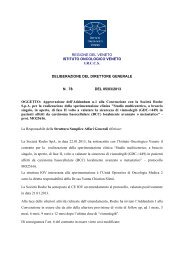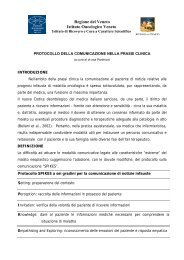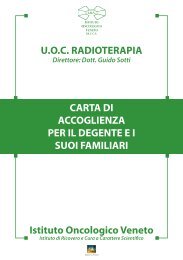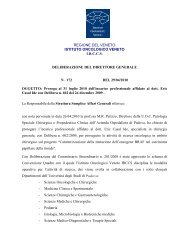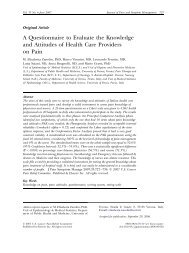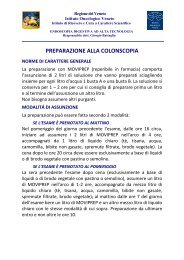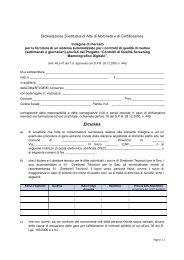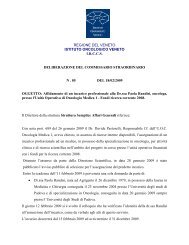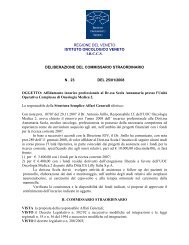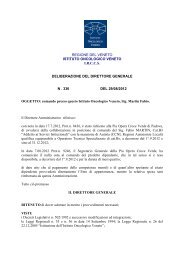SCIENTIFIC REPORT 2010 - 2011 - IOV
SCIENTIFIC REPORT 2010 - 2011 - IOV
SCIENTIFIC REPORT 2010 - 2011 - IOV
You also want an ePaper? Increase the reach of your titles
YUMPU automatically turns print PDFs into web optimized ePapers that Google loves.
Major Ongoing Research Projects<br />
The Medical Physics Unit has been recently involved in two<br />
projects concerning the verification of the accuracy of the dose<br />
distribution calculated by a commercial treatment planning<br />
system.<br />
COmmiSSiONiNG SiEmENS virTual wEDGES iN ThE<br />
ONCENTra TrEaTmENT plaNNiNG SySTEm uSiNG<br />
GafChrOmiC EbT film<br />
Principal investigator: Franca Simonato<br />
Contributors: Roberto Fabbris, Alice Ferretti, Sonia Reccanello,<br />
Roberto Zandonà<br />
Purpose. Virtual Wedges were introduced in Siemens<br />
LINAC to improve the treatment workflow. The aim of the work<br />
was the validation of dose calculation by MasterPlan-Oncentra<br />
treatment planning system for virtual wedged beams.<br />
Methods. The Oncor Siemens accelerator installed in the<br />
Radiation Therapy Unit produces 6 and 15 MV photon beams.<br />
At first, the consistency of VW LINAC production was tested and<br />
the EBT film measuring method was verified. Then, the measured<br />
and calculated wedge factors and beam profiles were compared.<br />
For 15°, 30°, 45°, and 60° wedge angles, the wedge factors for<br />
different field sizes were measured by an ionization chamber and<br />
the dose profiles acquired by Gafchromic EBT film.<br />
Results. The comparison between measured and calculated VW<br />
factors shows discrepancies that increase with field size and angle.<br />
The OTP Enhanced algorithm fits better with measurements than<br />
the Classic one, with overall improvement visible for large angles.<br />
The agreement between measured and planned beam profiles is<br />
within the limits reported by the ESTRO Booklet No. 7 in terms<br />
of confidence limits.<br />
Conclusions. The MasterPlan-Oncentra treatment planning<br />
system determines wedge factors and VW profiles within the<br />
requested accuracy in the majority of treatment conditions. For<br />
big field dimensions and wedge angle, wedge factor accordance<br />
was worse, but it could be increased with an improvement of the<br />
LINAC dosimetric board calibration.<br />
COmmiSSiONiNG Of a COmmErCial TpS baSED ON ThE<br />
vmC++ mC CODE fOr ElECTrON bEamS: valiDaTiON<br />
aND COmpariSON wiTh EGSNrC<br />
Principal Investigator: Andrea Martignano<br />
Contributors: Alice Ferretti, Franca Simonato<br />
Purpose. Some commercial TPS already use MC engines<br />
for dose calculation. The aim of this work was to perform the<br />
commissioning of the VMC++ Monte Carlo (MC) engine<br />
implemented in the Oncentra Masterplan TPS for electron dose<br />
calculation, and to verify its accuracy comparing the results to the<br />
EGSnrc MC code.<br />
Methods. The commissioning procedure for the TPS consists<br />
of measurements of output factors and profiles in x,y and z<br />
direction, in both air and water. The BEAMnrc MC code was<br />
used as a benchmark: BEAMnrc required the geometries of the<br />
LINAC head, which were provided by Siemens; the optimisation<br />
was done considering PDD and profiles in water. Commissioning<br />
results were evaluated by means of 1D Gamma Analysis (2%,<br />
2mm), calculated with a home-made Matlab program.<br />
Masterplan dose distribution maps were compared to the<br />
results of BEAMnrc, in two virtual phantoms: one made of<br />
water with an air insert, and the second with a bone insert. The<br />
comparison was done by means of 2D Gamma Analysis (3%,<br />
3mm), and comparing significant profiles and PDD.<br />
Results and conclusions. The results of the commissioning<br />
of the TPS were good. The optimisation of the BEAMnrc model<br />
of the LINAC required the modification of some components to<br />
match the calculated and measured profiles: the final agreement<br />
was very good. The agreement of the dose distributions calculated<br />
with the TPS and with EGSnrc with the air-insert phantom was<br />
high; with the bone-insert phantom there were differences of<br />
about 10-15% in the bone region. This is due to the fact that<br />
the Masterplan implementation of VMC++ reports the dose as<br />
“dose to water”, instead of “dose to medium” (therefore it is not a<br />
dosimetric error).<br />
THE DEPARTMENTS - DEPARTMENT OF RADIOTHERAPY AND NUCLEAR MEDICINE<br />
123



